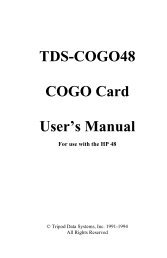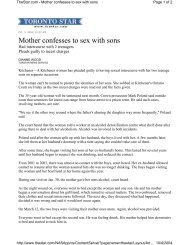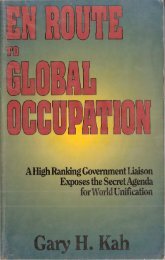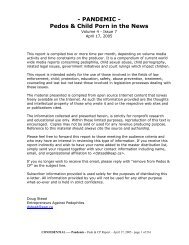G. Edward Griffin - The Fearful Master - PDF Archive
G. Edward Griffin - The Fearful Master - PDF Archive
G. Edward Griffin - The Fearful Master - PDF Archive
You also want an ePaper? Increase the reach of your titles
YUMPU automatically turns print PDFs into web optimized ePapers that Google loves.
An open foe may prove a curse; but a pretended friend is worse.<br />
Benjamin Franklin,<br />
Poor Richard's Almanac<br />
CHAPTER NINE: THE HOME TEAM<br />
In 1950 the State Department issued a volume entitled Postwar Foreign Policy<br />
Preparation, 1939-45. It described in detail the policies and documents leading up to the<br />
creation of the United Nations and named the men who shaped these policies. This and<br />
similar official records reveal that the following men were key government figures in UN<br />
planning within the U.S. State Department and Treasury Department: Alger Hiss, Harry<br />
Dexter White, Virginius Frank Coe, Dean Acheson, Noel Field, Laurence Duggan, Henry<br />
Julian Wadleigh, John Carter Vincent, David Weintraub, Nathan Gregory Silvermaster,<br />
Harold Glasser, Victor Perlo, Irving Kaplan, Solomon Adler, Abraham George Silverman,<br />
William L. Ullman and William H. Taylor. With the single exception of Dean Acheson, all of<br />
these men have since been identified in sworn testimony as secret Communist agents!<br />
It is truly fantastic, but here is the record:<br />
Alger Hiss: In 1950 Hiss was convicted and sent to prison for perjury involving statements<br />
relating to his Communist activities. Since the second Hiss trial evidence has continued to<br />
be amassed through other congressional investigations that is even more incriminating<br />
than that used for his conviction. As it was, the FBI had solid evidence of Hiss's<br />
Communist activities as far back as 1939 and had even issued numerous security reports<br />
to the justice Department and executive branch dealing with this fact. 1 In addition, a<br />
parade of former Communists testified that they personally had known and worked with<br />
Alger Hiss as a fellow member of the party.<br />
It is worth noting that Alger Hiss was very influential with the leaders of the Institute of<br />
Pacific Relations, which a Senate committee found to be infiltrated at the top by<br />
Communists. Hiss was one of the trustees of the IPR and was very active in its affairs. 2<br />
Mr. J. Anthony Panuch, who had been assigned the task of supervising the security<br />
aspects of the transfer of large numbers of personnel from various war agencies to the<br />
State Department in the fall of 1945, testified that as a security officer he had access to<br />
conclusive information on Hiss's Communist activity; but when he tried to do something<br />
about it, it was he, not Hiss, who was dismissed. 3<br />
In 1944 Hiss became acting director of the Office of Special Political Affairs which had<br />
charge of all postwar planning, most of which directly involved the creation of the United<br />
Nations; and in March 1945, in spite of all the FBI reports and other adverse security<br />
information circulating among the top echelons of government, he was promoted to<br />
director of that office.<br />
It is more than a little ironic that Alger Hiss was the man who traveled with FDR to Yalta as<br />
his State Department advisor. It was at the Yalta meeting that the decision was made to<br />
give the Soviets three votes in the General Assembly to one for the United States. Giving<br />
votes to the Russians for the Ukrainian SSR and Byelorussia SSR made as much sense<br />
as giving extra votes to the United States for Texas and California. At any rate, even if


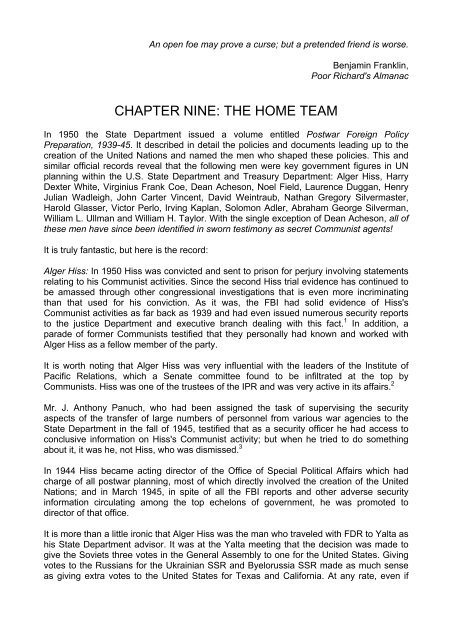
![Robert T McQuaid [rtmq@stn.net] Sent: Friday, October 29, 2004 12 ...](https://img.yumpu.com/51070071/1/190x245/robert-t-mcquaid-rtmqstnnet-sent-friday-october-29-2004-12-.jpg?quality=85)

